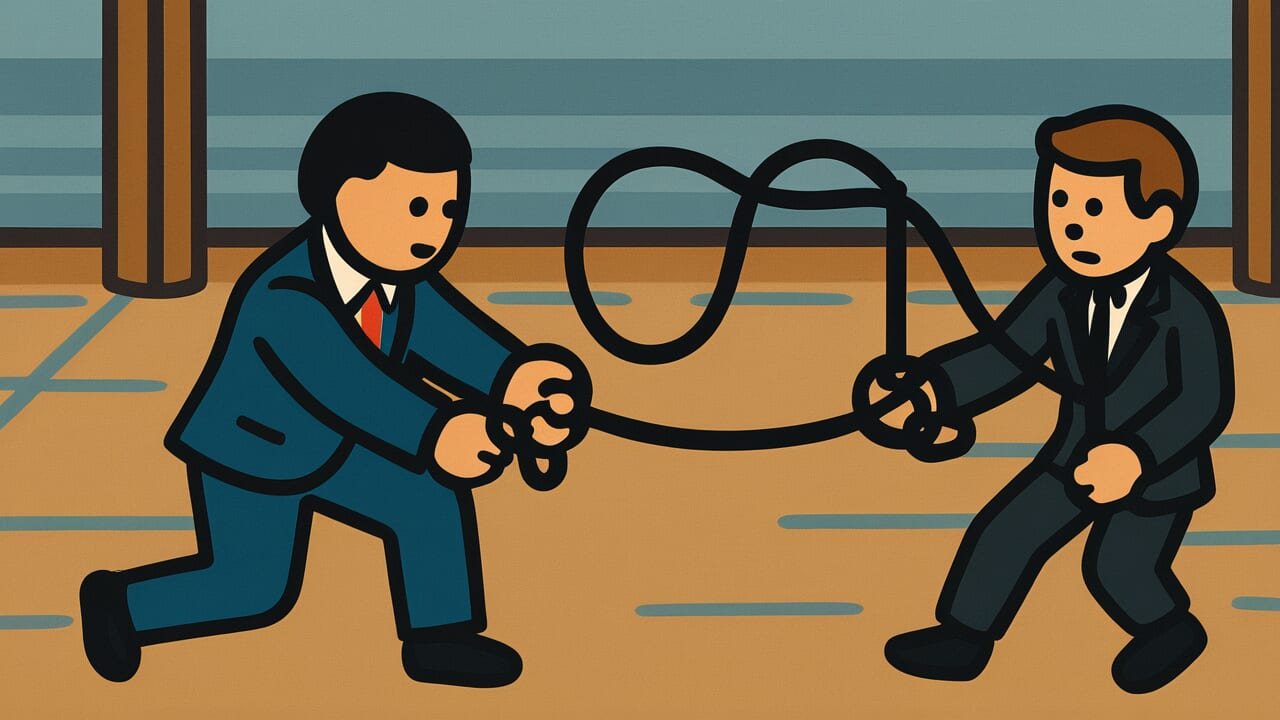How to Read “Pulling the legs of someone hanging themselves”
Kubikukuri no ashi wo hiku
Meaning of “Pulling the legs of someone hanging themselves”
This proverb describes an extremely heartless and cruel act. It means making things worse for someone who is already suffering or in a difficult situation.
Instead of helping them, you push them further toward destruction.
People use this saying when someone is already in a tough spot. Then others around them make things worse instead of offering help.
For example, taking money from someone who is already broke. Or attacking someone who is already mentally exhausted.
Or mocking someone who has failed and feels terrible about it.
We use this expression to strongly condemn such inhumane behavior. Words like “cold” or “mean” don’t capture how terrible these actions are.
The proverb uses an extreme life-or-death metaphor to show just how serious this is. It emphasizes that such acts lack even the most basic human compassion.
Even today, people use this saying to criticize actions that push vulnerable people further into despair. It highlights the cruelty of such behavior.
Origin and Etymology
No clear written records explain the exact origin of this proverb. However, we can understand it by looking at the words themselves.
“Kubikukuri” means hanging oneself by the neck. Since before the Edo period, some people chose to end their lives this way out of desperation or poverty.
These tragic situations left deep impressions on people’s memories.
The key part of this expression is “pulling the legs.” When someone hangs themselves, they stand on a platform or stool.
They jump off to end their life. If someone pulls their legs, they die regardless of whether they still want to live.
This means forcing someone toward death who might actually be seeking help.
Traditional Japanese ethics considered helping people in trouble a virtue. Especially in life-threatening situations, people believed you should help even strangers.
This proverb uses an extremely powerful metaphor to describe behavior that goes completely against these values.
It warns against losing human compassion by using the most shocking scenario possible. The saying serves as a warning about cold-hearted cruelty.
Usage Examples
- Refusing additional loans to a struggling company is one thing, but calling in existing loans too is like pulling the legs of someone hanging themselves
- When parents scold a bullied child who can’t go to school anymore, it’s equal to pulling the legs of someone hanging themselves
Universal Wisdom
This proverb has been passed down through generations because it reveals a serious contradiction in human society.
Sometimes people push down those who need help most. This is a sad reality.
Why do people act this way? One reason is that seeing someone weak makes them want to confirm their own superiority.
Also, people fear getting dragged into trouble by helping someone in need. So they distance themselves instead.
Furthermore, when someone is being attacked in a group, others might join the attack. They do this to avoid becoming targets themselves.
This proverb shows deep understanding of human nature. It doesn’t just condemn cruel acts.
It also recognizes the psychological mechanisms that create such behavior. Everyone carries weakness and fear inside them.
Because of this weakness, people sometimes hurt those they should help.
Our ancestors understood this human nature. That’s why they issued such a strong warning.
No matter how desperate the situation, we must not lose basic human compassion. When that disappears, society collapses.
Nobody can live safely in such a world. This proverb contains deep insight into human nature and wisdom for maintaining society.
When AI Hears This
Systems have “points of no return.” In physics, once you pass a critical point, all actions become counterproductive.
This proverb describes exactly that moment.
What’s interesting is that pulling the legs produces the same result whether done with good or bad intentions.
In system theory, once a system enters an irreversible process, it converts all intervention energy into “accelerated collapse.”
For example, during a stock market crash, government intervention might temporarily stop the decline. But it often amplifies investor anxiety and triggers even bigger sell-offs.
This happens because “the intervention itself proves the crisis exists.”
The essence of this proverb is choosing the wrong intervention point. Systems have multiple intervention points.
Early on, small forces can change direction. But after passing the critical point, the same force works destructively.
Pulling the legs could have saved a life before the hanging. This means “where you intervene” matters more than “what you do.”
Modern social media pile-ons follow the same structure. Early apologies can calm things down.
But explanations after a controversy passes its critical point become new fuel. When a system enters self-amplification mode, all inputs become amplification material.
This is the intervention point paradox.
Lessons for Today
This proverb teaches us fundamental attitudes about how to treat people in trouble.
In modern society, we see “pulling the legs of someone hanging themselves” in many forms. Online pile-ons, workplace harassment, and exploitation of the economically vulnerable are all examples.
On the internet especially, people attack those already being criticized. They do this to satisfy their own sense of justice.
But is that really the right action?
What matters is pausing to think when someone faces difficulties. Ask yourself if your actions are pushing them further into despair.
Even if you can’t help, at least don’t hurt them. That choice alone has real value.
Is there someone around you who is suffering right now? What can you do for that person?
It doesn’t have to be major support. Just listening or quietly watching over them can bring relief.
This proverb is an urgent message from our ancestors. They’re asking us not to forget the most basic human kindness.



Comments